 |
|

|
 |
TABLE of CONTENTS
 |
Governor, commissioner announce measures to improve transportation infrastructure
|
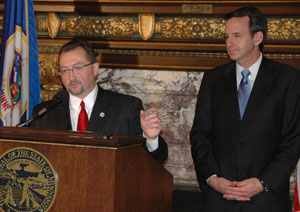
Commissioner Tom Sorel and Gov. Tim Pawlenty announced a number of initiatives on Oct. 27 that would improve the state’s transportation infrastructure and get Minnesotans where they need to go quickly, safely and efficiently. Photo by Nick Carpenter |
Innovative finance, public-private partnerships, a MnPASS study, Interstate 94 improvements and safety projects in Greater Minnesota were among the initiatives Gov. Tim Pawlenty and Commissioner Tom Sorel announced Oct. 27 that would improve the state’s transportation infrastructure and get Minnesotans where they need to go quickly, safely and efficiently.
“Positioning Minnesota for future success means making strategic transportation investments to move people and goods around our state more safely and efficiently,” Pawlenty said. “The initiatives we’re announcing today can be undertaken right away—they don’t require any additional legislation. Moving forward, we'll need to use innovative techniques like these to get the greatest possible value for our transportation dollar.”
The transportation initiatives are:
- Innovative finance - public-private partnerships
- Next stage MnPASS implementation study
- I-94 improvements between Minneapolis and St. Paul
- Low-cost/high-benefit congestion project acceleration
- Low-cost/high-benefit traffic safety solutions in Greater Minnesota
“With today's announcement we acknowledge the administration's commitment to safety, mobility, innovation, leadership, transparency and quality of life for our citizens,” Sorel said.
Innovative finance—public-private partnerships
Under the governor’s direction, Mn/DOT will increase the use of innovative finance and public-private partnerships (or P3s) to expand capacity and use transportation dollars to encourage targeted economic development.
These partnerships will be used to accelerate expansion projects by leveraging public and private resources to bring planned projects online faster and create opportunities where none were planned. Examples of P3 projects include:
- Reconstruction of the interchange at Hwy 169 and Bren Road in Minnetonka, which will accelerate needed improvements that will allow UnitedHealth Group to proceed with an expansion that will add more than 1,600 employees to its campus in Minnetonka. Construction of the expansion itself is expected to produce more than 1,400 jobs and $50 million in associated wages over the course of the project. Partners include Mn/DOT ($7 million), the Department of Employment & Economic Development ($1 million), the city of Minnetonka ($5 million) and UnitedHealth Group ($5 million).
- Construction of the new Hwy 52 Elk Run interchange in Pine Island just north of Rochester will aid the development of a new bioscience medical facility and supporting businesses. The 2,300-acre development will create numerous high-paying jobs and boost the state's economy. This project represents a partnership between Mn/DOT, DEED, Olmsted County, the city of Pine Island, the developer (Tower Investments) and a bio-business capital investing firm (Burrill & Co.). The total construction cost of the interchange project is estimated at approximately $36 million. Tower Investments and Burrill & Co. donated an estimated $13 million in right of way for the project.
Next stage MnPASS implementation study
Mn/DOT will identify additional Twin Cities area freeways that will benefit by the installation of a MnPASS congestion-pricing, high occupancy toll lane network. MnPASS lanes would be implemented in places where new capacity could be offered.
The study, which will be completed by September 2010, will look at the Twin Cities metro area highway system, evaluate traffic volumes, analyze travel patterns, identify geometric capabilities in various corridors, estimate construction and operating costs and determine revenue potential.
MnPASS has already been implemented on I-394 and last month on I-35W. Possible future routes include Hwy 77 between Eagan and Bloomington/Richfield, Hwy 169 between Shakopee and Bren Road in Minnetonka, and I-94 from the Fish Lake interchange to Hwy 101 in Rogers.
I-94 improvements between Minneapolis and St. Paul
During the I-35W bridge reconstruction, lanes were added to I-94 to manage increased traffic congestion, which greatly improved traffic flow. Proposed enhancements to this corridor include managed lane technology, high speed bus shoulders and eight lanes on I-94 between Hwy 280 and downtown Minneapolis.
In the future, one of the additional lanes and the bus shoulder would be converted to a MnPASS lane, allowing for another commuting option. Conversion of a lane/shoulder in each direction to a MnPASS lane is dependent on finding a low-cost solution for modifying the interchange at Hwy 280.
Low-cost/high-benefit congestion project acceleration
Another initiative will combine and accelerate $20 million to $40 million of low-cost/high-benefit congestion mitigation projects in the Twin Cities area. These are projects that typically cost $10 million or less and significantly reduce congestion.
Recently completed low-cost/high-benefit congestion mitigation projects include a $1.1 million interchange modification completed this month to allow westbound I-494 traffic to enter westbound Hwy 212 on an additional lane and a $7.1 million project adding lane capacity to northbound and southbound Hwy 100 between Hwy 7 and I-394 that was completed in October 2006.
Low-cost/high-benefit traffic safety solutions in Greater Minnesota
To reduce traffic fatalities and improve safety in Greater Minnesota, the governor is proposing aggressive implementation of safety strategies where the majority of the state’s fatal and serious crashes occur. This initiative will accelerate $3 million to $5 million in low-cost/high-benefit safety projects around Greater Minnesota.
Some of the low-cost strategies that provide high value to motorists include greater lighting at rural intersections to improve visibility, improved signage and pavement markings on curves, increased use of cable median barriers to reduce cross-over crashes, rumble strips to alert drivers who veer out of their lanes, and upgrading pavement striping to wet reflective markings that are more visible at night during rain.
For more information, see http://www.dot.state.mn.us/hottopics/index.html.
Workshop builds greater understanding of innovative finance for transportation projects
Nearly 130 transportation stakeholders representing local government, transportation interest groups, contractors, consultants, legislators and Mn/DOT attended the Innovative Transportation Finance Workshop on Oct. 20 in Shoreview.
What they walked away with was a better understanding of what innovative transportation financing is in general, why Mn/DOT should consider its use, what benefits it offers and what Mn/DOT is doing on that front.
“We don’t expect innovative financing to be a silver bullet for all the funding problems we face, but we do believe it will have an important role in solving the puzzle,” said Brad Larsen, Mn/DOT’s Traditional & Innovative Finance director.
A number of tools make up what is known as innovative transportation finance: new and non-traditional revenue streams; new financing tools and techniques; new methods of using existing revenue streams and financing techniques; and new types of financial partnerships between state, regional, local and private entities.
Larsen said there are many forces driving Mn/DOT’s exploration of innovative finance: the gap between needs and available resources; the fact that traditional funding services are not growing as they have in the past; debt capacity is becoming more limited; potential future federal incentive opportunities; and the department’s fundamental responsibility to continually look for ways to make better use of public monies.
Larsen outlined the potential benefits of innovative finance strategies and some of the key challenges to implementing certain strategies. He also summarized more than 20 tools and techniques that are currently being looked at to help accelerate transportation improvements.
Mn/DOT’s Innovative Finance Program is still in the early stages of development, but already has made significant progress in the areas of education and communication, legislative analysis and concept assessment.
During the coming months, Larsen said, the program will continue to build on the above areas, as well as pursue legislative proposals, begin concept testing and implementation, and ramp up the process of integrating innovative finance into Mn/DOT’s standard business practice.
For handouts from the workshop, as well as more information about Mn/DOT’s Innovative Finance program, see http://www.dot.state.mn.us/funding/innovative/. |
|
 |
|

|
 |
TABLE of CONTENTS
 |
Hwy 23 bridge in St. Cloud opens Oct. 29 |
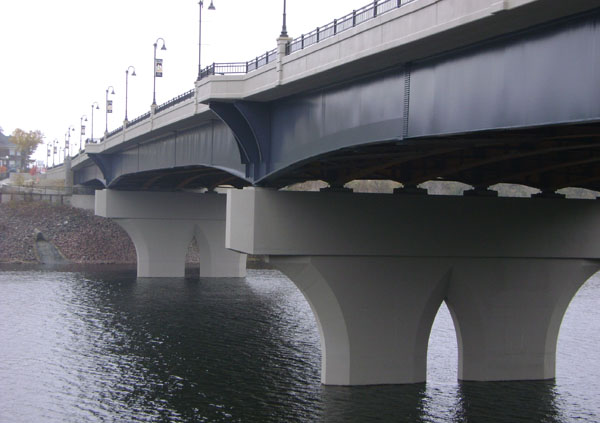
The new Hwy 23 bridge over the Mississippi River in St. Cloud is set to open to traffic on Oct. 29.
Granite City Crossing, formerly the DeSoto Bridge, was closed in March 2008 due to distortions found in gusset plates on four locations of the bridge. The old bridge was demolished in late August 2008.
Work on the $19.2 million Granite City Crossing began in October 2008. In addition to the bridge, $13 million of construction occurred along Hwy 23 from Washington Memorial Drive to 4th Avenue.
Construction activity will continue through mid-November as crews work on the Cloverleaf parking lot, Riverside Drive and the pedestrian trail at the east end of the bridge. Landscaping and area visual aesthetics will carry over into 2010. The entire project will be completed by June 2010. Photo by Dan Gilder
|
|
 |
|

|
 |
TABLE of CONTENTS
 |
Applications for oversize, overweight permits move to Web |
|
By Donna Lindberg
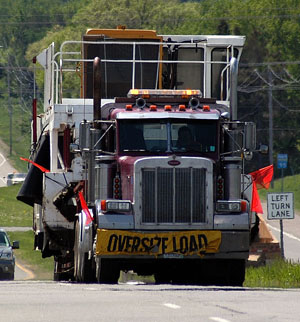
A vehicle with or without a load is considered overweight if it exceeds the 10-ton axle weight limit on Minnesota's state highway system. A vehicle with or without a load is considered oversize if it exceeds the legal maximum dimensions of 13 feet 6 inches in height, 8 feet 6 inches in width and 45 to 75 feet in length, depending on the type of vehicle. Photo by David Gonzalez |
Beginning Nov. 2, Mn/DOT will no longer accept phone-in permit applications for movement of oversized and overweight commercial and passenger vehicles over Minnesota’s state highway system.
Customers seeking permits will now have to apply online.
“The online permitting program allows customers to receive their permit much faster,” said Ted Coulianos, Oversize/Overweight Permit Section supervisor. “Also, many single trip permits can be issued automatically without assistance from permit staff.”
In 2008, the section handled more than 15,000 inbound calls resulting in about 50-60 applications per day—an increase of 27 percent and a job that required the services of three full-time employees.
“Although 13 percent of customers apply for permits by phone, it requires 35 percent of staff time and resources,” Coulianos said. “This change will help us plan ahead to possible future loss of senior techs due to retirement and attrition.”
Mn/DOT has been accepting phone-in oversize and overweight permit applications for 40 years.
“More and more customers are expecting to do business with us online,” Coulianos said. “Currently 59 percent of our customers use our Web application service and we’d like to increase that number.” |
 |
|

|
 |
TABLE of CONTENTS
 |
Amendment to Ted Foss “Move Over” Law inspires new public service announcement |
By Beth Petrowske
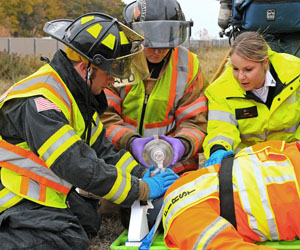
Members of the Albertville Volunteer Fire Department and Allina Transportation paramedics added a sense of realism to the PSA. Photo by David Gonzalez |
The Ted Foss “Move Over” Law, Minnesota Statute 169.18 subdivision 12, was amended in 2008 to include all road repair equipment. This means that, in addition to moving over one lane for all emergency response vehicles, motorists must now move over for all road repair equipment.
On Oct. 20, a public service announcement was taped in an effort to help people understand the change in the law.
“Adding construction and maintenance equipment and FIRST vehicles to this law is a good thing for Mn/DOT,” said Amr Jabr, Metro District Operations and Maintenance Office director. “We hope the PSA will increase awareness and compliance with the law and will result in improved safety for our employees and the public.”
The PSA was taped on a closed section of westbound I-94 at the Minnesota Road Research Project test facility in Monticello. About 35 Mn/DOT employees and volunteers were involved in the day-long taping. Two contracted videographers and an audio technician rounded out the crew.
The storyline in the PSA portrays an inattentive driver played by Metro District's J.P. Gillach, who crashes into the back of a parked FIRST truck. The collision kills the Mn/DOT driver, played by Jason Henry, who is a real FIRST driver.
Playing a FIRST driver who has been hit on the job came naturally to Henry, who has been rear-ended three times in the last several years. Fortunately, he was inside his vehicle during each of the crashes and was not seriously injured.
The completed 30-second PSA will be made available to TV stations statewide later this fall.
“Move Over” Statistics
2009
- To date, 86 construction, maintenance and FIRST vehicles have been hit by motorists
- 10 employees and four citizens have been injured
2008
- 101 Mn/DOT construction, maintenance and FIRST vehicles were hit by motorists
- Seven employees and 10 citizens were injured
- One citizen was killed
|
|
 |
|

|
 |
TABLE of CONTENTS
 |
Number of pedestrians killed by trains doubles in 2009 |
By Donna Lindberg
Two people were killed by trains last week while walking on or across railroad tracks in Minnesota, which raises the number of 2009 rail-related pedestrian fatalities to 11, the highest number in 10 years. There were only five rail-related pedestrian fatalities in Minnesota in 2008.
A 51-year-old man was killed Oct. 19 near Winona State University when he tripped at a pedestrian crossing and fell in front of an oncoming Soo Line train.
“It's easy to misjudge a train's speed and its distance,” said William Gardner, Mn/DOT’s director of Freight, Rail and Waterways. “It can take a mile or more for a freight train moving at 55 miles an hour to stop after the engineer hits the brakes.”
On Oct. 20, a 24-year-old man was struck and killed by a Burlington Northern Santa Fe freight train at a railroad crossing west of Litchfield. The train sounded its whistle prior to the accident, but the victim was believed to be wearing headphones at the time.
“Stay alert for trains when approaching railroad tracks and limit distractions such as cell phones, headphones and music listening devices,” Gardner said. “Only 30 percent of the 4,362 railroad crossings in Minnesota have active warning devices.”
Walking on railroad tracks in Minnesota is considered trespassing. Anyone who violates the law is guilty of a misdemeanor and is subject to a penalty.
“A 2008 law passed makes it illegal to trespass on railroad tracks or railroad property,” said Gardner. “This law adds an extra measure of safety in urban areas where we are seeing more and more new light rail transit and commuter rail lines. More railroad tracks provide more opportunities for injuries and fatalities.”
For more information on railroad crossing safety, visit the Operation Lifesaver, Inc., Web site at www.oli.org. |
 |
|

|
 |
TABLE of CONTENTS
 |
Historic Hwy 60 bridge in Faribault reopens to traffic |
By Nick Carpenter

There is now 53 feet from curb to curb on the new bridge deck compared to 30 feet on the old deck. Photo by Chad Casey |
After nine months of construction and meticulous maneuvering, the historic Faribault Viaduct Bridge that carries Hwy 60 over the Straight River and Union Pacific Railroad reopened to traffic on Oct. 17.
Work started in February on the $8.9 million project, which called for the replacement of the old bridge deck and the reconstruction of approximately four blocks of Hwy 60 in downtown Faribault.
Built in 1937, the original deck arch bridge is on the National Register of Historic Places and has stood largely unmodified for more than 70 years. Due to the historic designation of the structure and its landmark status in the community, crews worked carefully to make sure that all the salvageable elements of the bridge were maintained.
“It was challenging, but I think we succeeded in maintaining the bridge’s historical integrity,” said Chad Casey, Rochester/District 6 project engineer. “We made sure that everything in good condition was kept as part of the new structure and those elements we couldn’t keep were designed to fit in with the original structure.”
The three original concrete arches, as well as the spandrel columns and adjacent piers were retained. The historic retaining wall underneath the structure was also left in place.
Recently retired Mn/DOT bridge designer Arlen Ottman and project manager Fausto Cabral headed the design phase of the project. It was their job to make sure the design aspects of the new bridge reflected the style of the historic bridge.
In order to replicate the architectural elements of the original structure, custom-ordered lights and ornamental railings were required to match the original designs. Mn/DOT hired a consultant to make sure the light fixtures and railings were painted the same light green color that was used in 1937.
Mn/DOT also hired a contractor to monitor vibrations at the nearby Alexander Faribault House, which is also a historic landmark. To ensure the integrity of the house, monitoring was conducted prior to construction for baseline levels as well as during vibration-producing activities like pile driving.
Maintaining the bridge’s historical integrity presented many challenges as crews worked to build a structure that would last more than 70 years.

Due to the historic designation of the structure and its landmark status in the community, crews worked carefully to make sure that all the salvageable elements of the bridge were maintained. Photo by Jessica Wiens |
“The old bridge was deteriorating,” Casey said. “We needed to address some important safety concerns and at the same time increase capacity on the bridge.”
Crews shortened the bridge from 1,000 feet to 750 feet and widened it from 45 feet to 70 feet to make room for new turn lanes, safety railings and sidewalks. There is now 53 feet from curb to curb compared to 30 feet on the old bridge deck.
In addition to the safety railings and sidewalk improvements, crews widened the intersection at First Avenue and Division Street, which will make turning movements coming off the bridge a lot easier, according to Casey.
Improvements to the bridge resulted in the addition of 740,000 pounds of reinforcing steel to the old concrete structure, which presented some unique challenges for crews.
“Retaining elements of the original structure and retrofitting the new bridge components added complexity to the staging of this project,” Casey said. “Perhaps the most innovative aspect of the project involved maintaining the historic arches as we worked to replace the deck.”
A precise removal process was required for the old bridge deck and the presence of the Straight River under one of the arch spans drove additional innovative practices. The river is a state-protected waterway and a recreational canoe route, which not only brought up further access and staging issues, it created an environmental obstacle.
“To solve this challenge, the contractor built a protective platform over the river to protect it from falling debris,” Casey said. “In addition to protecting the river, the platform provided a work bridge that helped solve some of the access issues.”
Crews also used crushed concrete from the original bridge as the base for the road and sidewalks on the four-block road reconstruction portion of the project in downtown. One hundred percent of the aggregate base used was crushed bridge concrete.
The final product is the result of several years of planning and partnering. Mn/DOT worked with the city of Faribault, the state historical preservation office, the Department of Natural Resources, the Pollution Control Agency and the Union Pacific Railroad on this project. The department also sought public input at meetings held during the design phase.
“It was satisfying to have the opportunity to bring every stakeholder together and help them embrace the proposed solution for this project,” said Fausto Cabral, design project manager. “It is really satisfying to see the final result of all the hard work everyone put in.”
Hwy 60 bridge walking tour draws Faribault community
By Kristin Calliguri
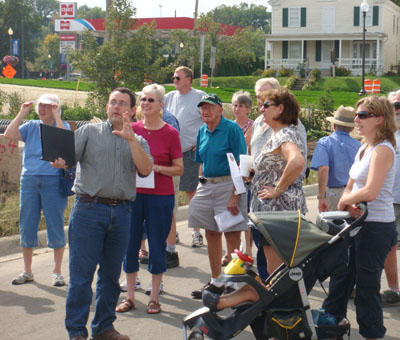
Chad Casey, Rochester/District 6 project engineer, points out the historic arches that were retained from the original bridge during one of the walking tours. Photo by Kristin Calliguri |
Faribault community members gathered near the Hwy 60 bridge on Sept. 19 for the first-ever bridge walking tours in District 6.
During the four tours given that day, Mn/DOT highlighted the added efforts it has taken to maintain the historic nature of the Hwy 60 bridge. The first tour was well-attended and allowed for standing-room-only at a nearby restaurant. About 65 people took the tour, including Faribault Mayor John Jasinski and Rep. Patti Fritz.
District Engineer Nelrae Succio and Assistant District Engineer Mark Panek greeted the tour groups with a brief history of the bridge and the process it took to get to this point.
Chad Casey, project engineer, went into more detail about the construction process, highlighting the new parts of the bridge as well as the historic parts of the bridge that were retained. After the short presentation, Casey led the tours near the bridge to view the construction progress.
Many Faribault residents attended the tours and shared their own stories of the bridge. One resident told the tour group that he believes he has a wrench that was used to construct the original 1937 bridge. A construction worker found it this spring while demolishing the old bridge deck. The man believes it was dropped into the wet cement in 1937, and he is very excited to have a piece of bridge history.
“During each tour, I received tons of positive feedback from the community members about how happy they were that so much of the original bridge was left in place,” Casey said. |
|
 |
|

|
 |
TABLE of CONTENTS
 |
E-Magination JAM moves forward |
|
The results of E-magination JAM are in, but the work has just begun.
“We have reviewed the more than 500 entries and found that they fell into several key themes,” said Susan Hall, project manager. “This grouping will help Mn/DOT leadership determine which ideas are most feasible to pursue given the themes and other considerations, such as the ideas’ link to the Strategic Directions—Safety, Mobility, Innovation, Leadership and Transparency.”
Examples of themes include traffic and operation innovations, innovative financing and ways Mn/DOT can “go green.”
A report containing the ideas gained from the E-magination JAM event is now available at http://ihub.dot.state.mn.us/riskmanagement/docs/jamidearegister.pdf.
The chosen theme areas and related ideas will be announced in early November. Mn/DOT leadership will then review the ideas and begin to identify which ones need additional resources for implementation.
In the meantime, there are a lot of great ideas that can be implemented without requiring direction from leadership or significant resources or staff to implement, Hall said. Offices are encouraged to read through the results and follow up on ideas when possible.
“It is wonderful to see the enthusiasm for this project,” She said. “I am pleased to hear that many of the ideas presented are already being looked at. Some of the ideas are related to projects or programs underway.”
Assessing the risks involved in implementing new ideas may be helpful, according to Hall. The Risk Management staff is available to help employees evaluate ideas. Employees interested in learning more about Risk Management can visit http://ihub/riskmanagement.
If you or your office has already made changes based on ideas generated by E-magination JAM, please contact Susan Hall at 651-366-3173.
Search engine improvements coming your way
Many people who participated in E-magination JAM expressed frustration with Mn/DOT’s search engine.
Mn/DOT actually has two search engines—an internal search engine that searches only sites within Mn/DOT’s iHUB—and the external search engine that searches the external site. Improvements to both are underway.
The application development group has already made behind-the-scene changes that improve the way the internal search engine works.
Webmasters will be receiving a note soon with information about additional steps they can take to ensure that their iHUB and external Web site pages have the proper coding to allow them to be found by the search engines. |
 |
|

|
 |
TABLE of CONTENTS
 |
Owen Gohlke appointed new chief financial officer |
Owen Gohlke is set to become the new chief financial officer effective Nov. 2. His responsibilities include:
- Serving as Mn/DOT’s chief financial spokesperson in working with the legislature and other state agencies
- Directing the development of the agency’s budget
- Providing creative alternative financing solutions to meet the increasing demands of maintaining and improving the state’s transportation infrastructure
- Advising the commissioner and executive management team on financial policy and budget issues
- Providing managerial oversight to the financial functions to ensure objectives are met in the most efficient and effective manner
Gohlke has served in a number of executive leadership roles, most recently as the CFO and vice president of the CES Group, Inc., a multi-site HVAC manufacturing organization based in Chaska. He has more than 20 years of private sector financial management experience.
Gohlke has a Bachelor of Science in Accounting and Finance from Mankato State University, a Master of Business Administration in Finance from the University of Texas, and is a certified public accountant.
Gohlke’s office will be located on the 4th floor. He can be contacted at 651-366-4816. |
 |
|

|
 |
TABLE of CONTENTS
 |
I-35W bridge replacement wins America’s Transportation Awards’ Grand Prize |
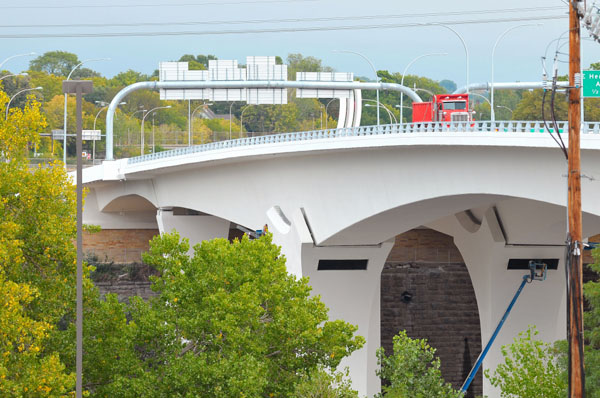
The Interstate 35W bridge replacement project was awarded America’s Transportation Awards’ Grand Prize for 2009 on Oct. 25 by the American Automobile Association, the American Association of State Highway and Transportation Officials and the U.S. Chamber of Commerce.
Mn/DOT received a $10,000 award that must be used to support a charity or academic scholarship program of its choice.
The I-35W bridge replacement project was also in the running for the People’s Choice Award, which was selected through online voting. Florida Department of Transportation received the award for its Interstate 95 Express Miami project.
Ten projects were nominated for the two awards by a panel of judges who evaluated 50 highway projects from 33 states in three categories: “On Time,” “On Budget” and “Innovative Management.” Photo by David Gonzalez
|
|
 |
|

|
 |
TABLE of CONTENTS
 |
Around Mn/DOT |

Critical pieces of debris from the collapsed I-35W bridge will be housed in a 5,000-square-foot facility in Oakdale while litigation over the collapse pends. Photo by Chris Joyce |
Steel from 35W bridge returns to Minnesota
Steel bridge debris that the National Transportation Safety Board analyzed as part of its investigation of the Interstate 35W bridge collapse returned to Minnesota early on Saturday, Oct. 17. The steel had been in the state of Virginia since fall 2007.
Five semi-trailers carried the twisted and rusting steel, considered to be critical to the NTSB investigation, to the 5,000-square-foot facility Mn/DOT built in Oakdale to protect and store the bridge material. The steel pieces, weighing from a couple hundred pounds up to 10,000 pounds, rest on wood planks laid out on a concrete floor six inches thick. The bridge steel will remain in the building while litigation over the collapse pends.
Also being stored in the Oakdale facility are the bridge bearings, weighing up to 12,000 pounds each, and the 2,000-pound rollers for the bearings. These were trucked over earlier this month from Bohemian Flats in Minneapolis, which lies a couple of hundred yards downriver from the collapse site. Other structural pieces, too large to move without cutting them, remain on the flats.
Training program readies snowplow operators for winter
More than 200 snowplow operators will complete an intensive training program Oct. 30 to prepare them for the worst road conditions a typical Minnesota winter has to offer.
Mn/DOT’s snowplow operator training program, known as SPOT, features two separate two-week sessions that highlight a variety of safety measures, plowing techniques and best practices. The sessions provide trainees with updates on new equipment, policies and procedures related to winter highway maintenance operations.
“Most of the trainees are new Mn/DOT employees and it is mandatory for them to attend one of the two-week sessions,” said Rick Shomion, SPOT trainer. “It is essential that we not only educate the drivers, but give them the opportunity to demonstrate their operator skills under real and simulated conditions.”
In addition to new Mn/DOT employees, Mn/DOT veterans who want to improve their skills and snowplow operators from township, city, county and tribal governments also participate.
SPOT began in 2004. When the current session ends on Oct. 30, Mn/DOT will have trained nearly 800 snowplow operators at the training facility at Camp Ripley near Little Falls, Minn.
Open enrollment begins Nov. 4
This year’s open enrollment period will be held from Nov. 4 - 17.
Open enrollment allows employees to change their medical or dental insurance carriers and add or drop dependent coverage on medical or dental insurance. Employees may also enroll in or increase long-term disability.
Additionally, employees can enroll in the 2010 pre-tax accounts for the medical dental expense account, dependent care or daycare expense account and the transit expense account. Those with Optional Employee or Spouse Life will have an opportunity to increase coverage per the schedule listed on the MMB Web site.
Employees considering retirement in the near future can attend one of the following special retiree-focused open enrollment meetings:
- Nov. 2--MSRS building at 60 Empire Drive in St. Paul
- Nov. 9--Brainerd Public Library
- Nov. 10--Rochester Public Library
For more information on open enrollment, visit http://www.mmb.state.mn.us/ins-oe or send questions to cobenefits@dot.state.mn.us.
Violent Incident Advisory Team holds symposium on workplace violence
Seventy-five employees gathered at the annual violence symposium in St. Cloud on Oct. 19 to discuss how to deal with bullying, intimidation and physical threats in the workplace.
Mn/DOT’s Violent Incident Advisory Team led the symposium, “The Workplace Violence Continuum.”
Violations of Mn/DOT’s Zero Tolerance of Violence policy are steadily increasing every year, according to DeLorah Curry, Human Resources’ organizational health consultant. In 2008, there were 31 investigated and substantiated incidents of violations at Mn/DOT.
Dr. John Nicoletti, a psychologist who specializes in identifying, assessing and defusing attack-related behaviors and violence in various workplaces and schools, served as the keynote speaker.
The symposium also provided an opportunity for employees to share their own stories about violence in the workplace and learn about resources that are available to them, including VIAT.
“We want people to know that there are resources available, and that we need them to report incidents to us as well,” Curry said “We spend a third of our life here at work, so we need our job environment to be a decent and safe place to be in.” |
 |
|
| |
|



